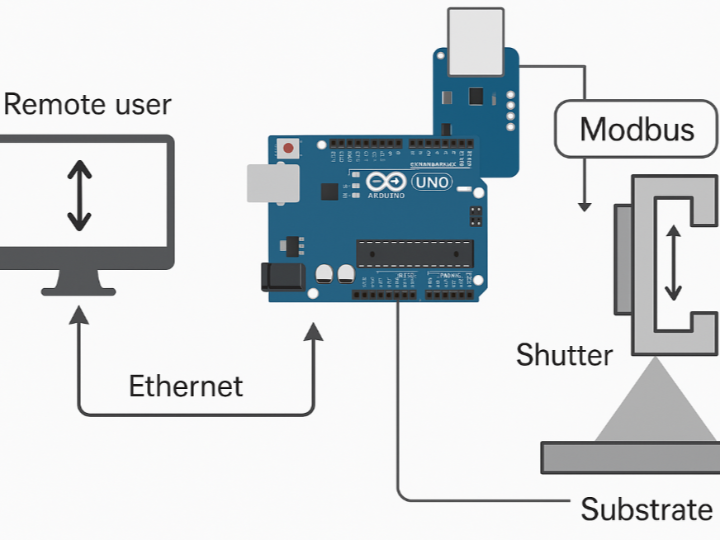W5500 Use Case: Shutter Control in Molecular Beam Epitaxy (MBE) Systems
W5500 enabled the US Army Research Lab to replace a costly, proprietary MBE shutter control system with a low-cost, open-source Arduino solution.

1. Background: What is an MBE System?
Molecular Beam Epitaxy (MBE) is a precision thin-film growth technology used in semiconductor and advanced material research.
Each MBE chamber contains shutters that block or allow atomic beams from elemental sources to reach the substrate. The exact timing of shutter actuation determines the composition and structure of the resulting crystal — accuracy is critical.
2. The Problem with Legacy Systems
Traditionally, shutter control relied on National Instruments PCIe I/O cards and proprietary OEM software.
Extremely costly (tens of thousands of dollars)
Dependent on specific PC hardware and operating systems
No true feedback from shutters (software assumed shutters moved, even if they jammed)
Limited portability and long-term maintainability
This made MBE operation expensive, inflexible, and unreliable.
3. A New Approach: Open-Source + Ethernet Control
To solve these issues, the US Army Research Laboratory (ARL) developed an open-source shutter controller.
Arduino Mega → central logic
Wiznet W5500 Ethernet Shield → Ethernet interface using Modbus TCP
Solid-State Relays (SSR) → drive 24V shutter solenoids
MCP23017 I/O Expanders → handle shutter sensors and LED indicators
In other words, a low-cost Arduino + W5500 setup replaced expensive proprietary hardware, while still integrating with OEM MBE control software.
📌 Example Code Snippet (simplified)
// Setup: initialization
Wire.begin(); // I2C for port expander
Serial.begin(9600); // Debugging
Ethernet.begin(mac, ip); // Initialize W5500 Ethernet
for (int i=0; i<16; i++) {
pinMode(shutterControl[i], OUTPUT); // Shutter outputs
}
// Main Loop: Modbus processing
Mb.Run(); // Handle incoming Modbus TCP packets
for (int i=0; i<16; i++) {
changeShutter(i, shutterCommand[i]); // Actuate shutter
if (shutterOpened[i]) LED[i].Green(); // Feedback LED
else LED[i].Red();
}➡️ Ethernet.begin() configures the W5500 for Modbus TCP communication.
➡️ Mb.Run() processes Modbus packets, translating Ethernet commands into shutter actions.
4. The Key Role of W5500
The W5500 Ethernet chip acts as the gateway between industrial control software and the open-source Arduino platform.
Enables standard Ethernet communication (Modbus TCP)
Compatible with OEM control software
Works with any PC or laptop with an Ethernet port
Ensures future-proof connectivity without proprietary drivers
5. Value for Users
Researchers: Affordable, reliable shutter control
Engineers: Fully customizable, open-source design
Industry: Freedom from vendor lock-in and reduced maintenance costs
The W5500 is not just an Ethernet chip — it is the key enabler of low-cost, future-proof control systems.
6. Marketing Takeaways
“Even advanced MBE systems run on W5500.”
“Replace $20,000 control systems with a $50 open-source solution.”
“Proven in industrial and research environments.”
“Open-source + W5500 = the new standard for control systems.”
👉 With this narrative, the W5500 can be positioned not only as a networking chip, but as a trusted, field-proven solution in demanding industrial and research applications.

